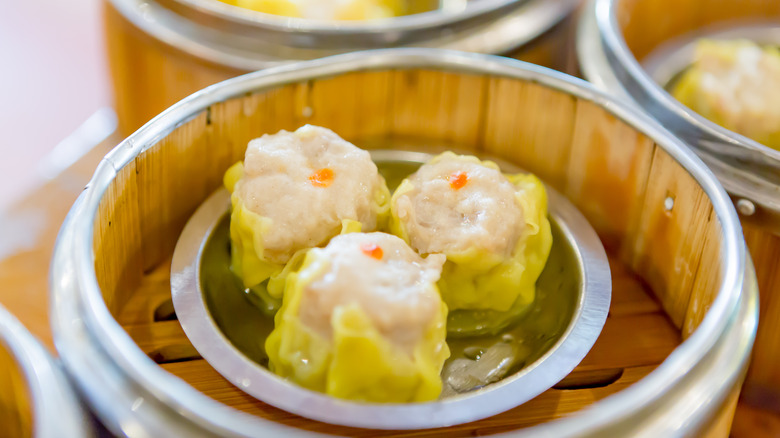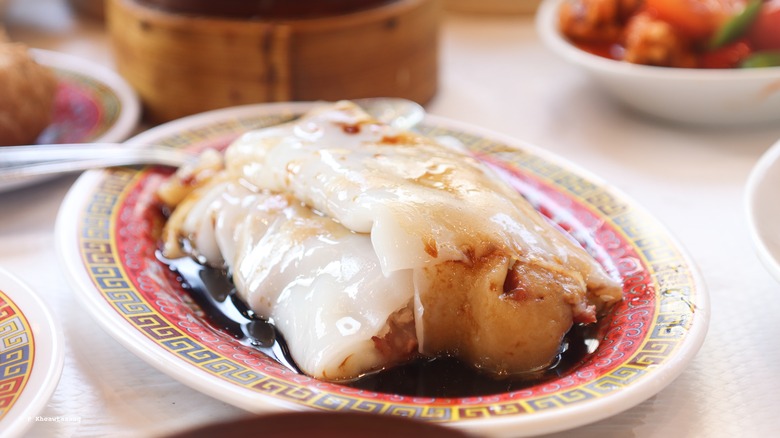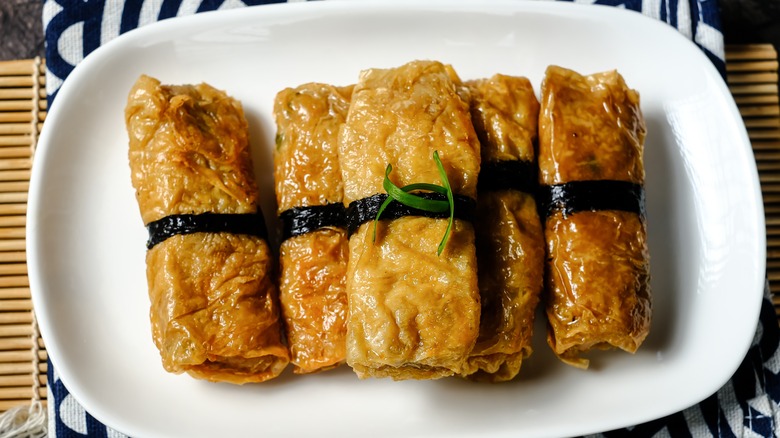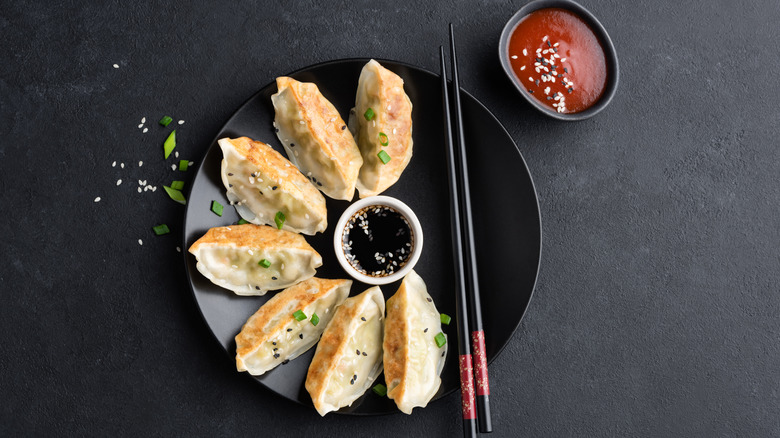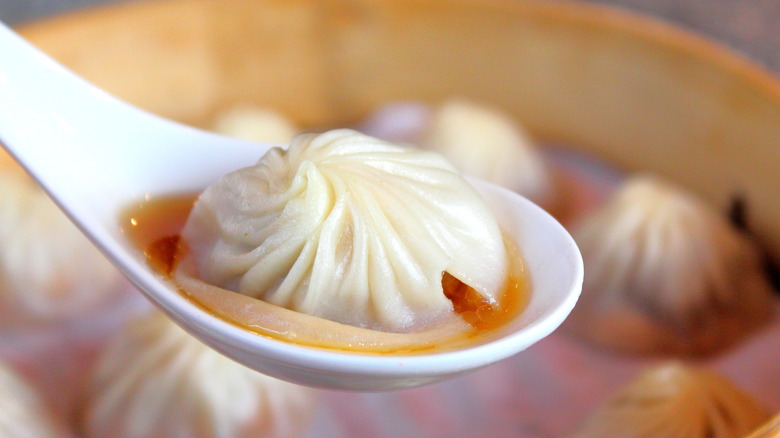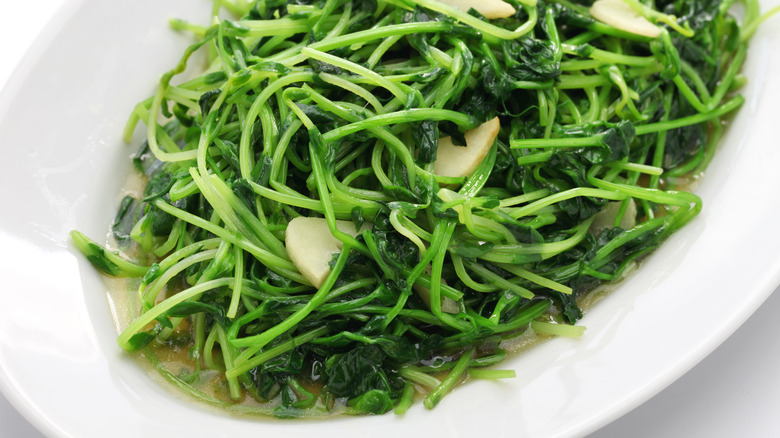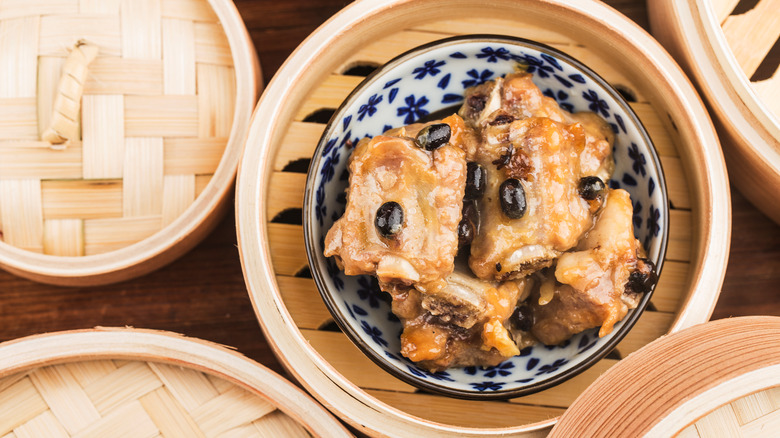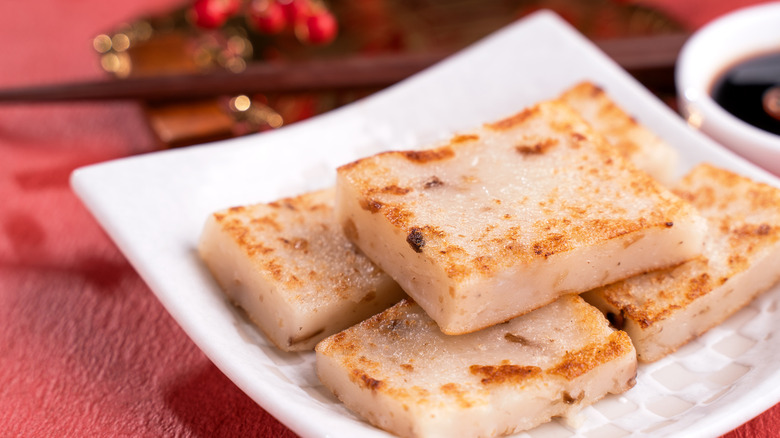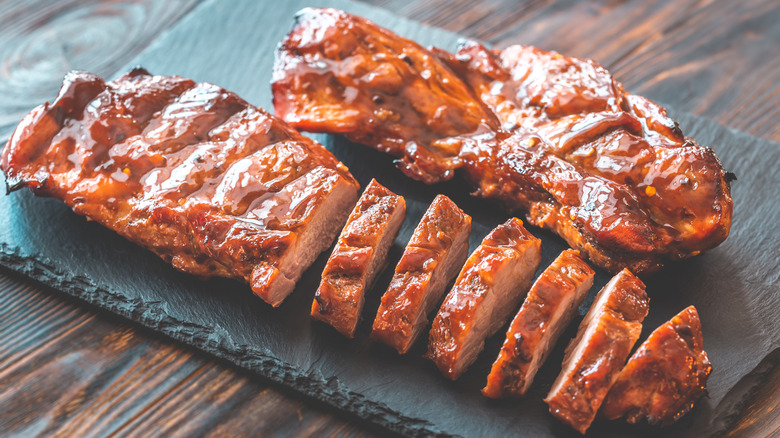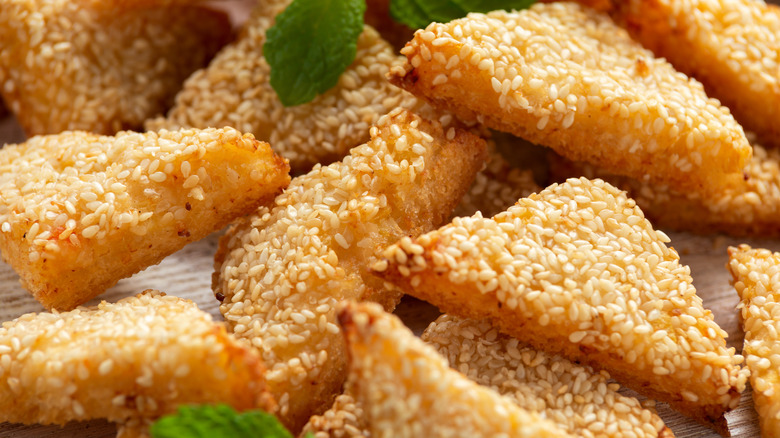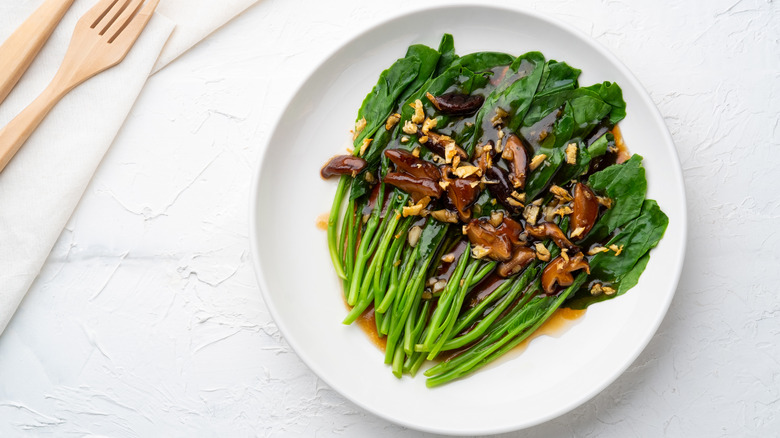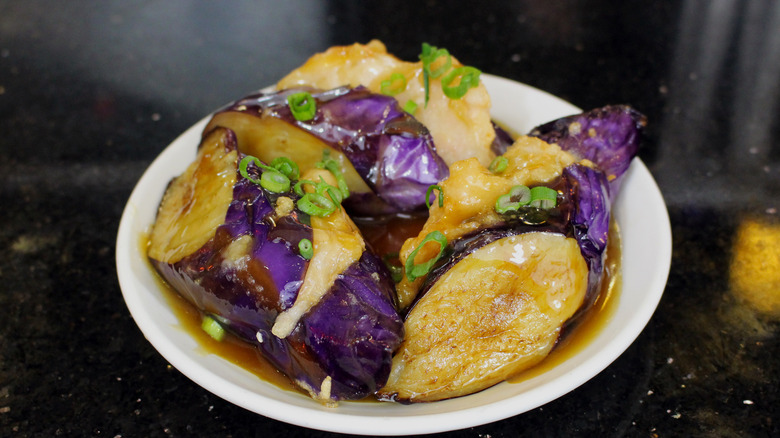The 17 Must-Order Dishes For A Dim Sum Feast
The term dim sum translates to mean "touch the heart" and originated within Cantonese cuisine, known for its variety of foods and use of ingredients (via Yauatcha). Historically, it was originally served as a snack alongside tea to travelers in need of rest while traversing the Silk Road throughout the country.
The name dim sum — indicative of its small, snack-sized portions — has since grown into a popular full-blown meal, often of epic proportions. Tea, however, is still considered to be part of the experience of dim sum and should be ordered alongside food.
Those in the midst of the dim sum experience for the first time might feel overwhelmed at the sheer variety of choices available as well as the amount of interaction required of diners. From walking around to picking up bamboo baskets or plates off trollies to tea pouring, lazy Susan spinning, or weaving chopsticks to reach, pass, and enjoy your favorite dish, going out for dim sum could be compared to an immersive theatrical experience. Despite its origins, it is now traditionally more of a weekend brunch kind of affair, when there is plenty of time to eat, chat, read the paper, and enjoy a leisurely extended meal with friends or family.
Here are some of our very favorite dim sum dishes for you to try during your next dim sum meal out.
Siu mai
If you're looking to order something tender and meaty, siu mai (or shumai) should be your first port of call. This open dumpling is traditionally stuffed to the gills with garlic, ginger, minced pork, and shrimp, encased by a thin dumpling skin, and steamed to perfection. Drizzled or dunked in a mixture of soy sauce and black vinegar, siu mai is an incredibly satisfying bite.
Though the dumpling graces many a table and lazy Susan on Sunday mornings in Hong Kong, a time when many families gather at the local dim sum house for an extended feast and catch up, its origins can actually be linked to inner Mongolia, according to South China Morning Post.
Thankfully for us, it is also one of the less complicated dumplings to make, as the folds require more of a squeeze rather than intricate techniques, to achieve. Next time the craving hits, give our pork and shrimp shumai recipe a try.
Cheung fun
In many regions of China, texture plays just as large of a part in the attribute of the dish as the taste. Such is the case with this very popular dish.
Cheung fun is a dish eaten both for its taste and for its silky, slippery texture. Originally a breakfast dish from the providence of Guangdong, it is now a mainstay of dim sum feasts all over the world. The dish is made by steaming a rice flour-based batter into long sheets, which can then be cut and wrapped in a variety of different ways, before being served. They are best when eaten just moments after being made and are generally not a dish that can be made in advance.
The dish can be eaten in many ways: simply rolled, drizzled with soy sauce, scallions, and sesame seeds, or filled with shrimp, pork, or even a savory Chinese breakfast doughnut called Youtiao.
Lo mai gai
Lotus leaves are a natural ingredient used across much of Asia. Much like corn husks or banana leaves, lotus leaves are used to hold together and protect ingredients such as rice, vegetables, and meats when being steamed. Through the steaming process, the water vapor also helps to infuse ingredients inside with the subtly sweet flavor of the leaves. Lotus leaves' water-resistant texture makes them a perfect vessel for this method of cooking.
Lo mai gai is an excellent dim sum option when looking to balance out some of the deep-fried or heavily flavored dishes with something a bit more subtle, soft, and steamed. The filling, made with glutenous (or sticky) rice, typically contains chicken, Chinese mushrooms such as shiitake, and lap cheong or wind-dried Chinese sausage to create an earthy, naturally sweet flavor profile. The soft comforting textures and subtle flavors make this a must-order in our book.
Beancurd roll
For those out there who claim to dislike tofu, we beg you to try tofu skin. Its paper-thin, satisfyingly chewy texture might just be the thing that changes your mind about the soybean substance. Though it may not be at your local grocery store, most Asian groceries stores will carry it, so do ask around.
One stand-out dish made from tofu skin is beancurd rolls or tofu rolls, found on many dim sum menus around the globe. A stuffing often consisting of shrimp, pork, carrots, cabbage, mushrooms such as cloud ears or wood fungus, and bamboo shoots is wrapped with the tofu skin. Rolls are then cooked twice — first deep fried and then steamed — to create incredibly satisfying and texturally diverse finished products. Though perhaps a bit fussy to make at home, these are not to be missed when treating yourself to a dim sum meal out.
Jiaozi
Dumplings are pretty much a guarantee within any cuisine or culture, from ravioli to perogies to empanadas. Making a dough to then fill with whatever bits of vegetables or meats are left lying around to stretch the food a bit further is as universal as it is delicious. Chinese cuisine is no exception. In fact, jciaozi may be one of the older dumplings around, dating back to the Han Dynasty (via History).
More commonly known as gyoza or even pot stickers in the U.S., jiaozi are closed dumplings that are both steamed and pan-fried to create a combination of textures: soft and tender on the top with crispy bottoms where the dumplings meet the pan. Another universal truth about dumplings, and especially jiaozi, is that you can never order too many.
Chicken feet
Chicken feet are a labor of love, as ubiquitous in China and many parts of Asia as chicken wings in the U.S. Like wings, to make the dish tender and delicious, it goes through several stages of cooking, including blanching and braising or deep frying then steaming. These processes insure the "chicken accessories," as writer Yiwie Gu calls them, are cooked to perfection and infused with as much flavor as possible (via Matador Network).
Not just for dim sum, chicken feet are eaten cold, hot, pickled, and deep-fried throughout many Asian countries as part of a meal or a snack. They are rich in collagen, and, much like chicken wings, evoke a specific pleasure derived from the process itself of eating them.
Tau fu fah or doufu hua
Those who love the soft creamy textures of panna cotta or custard should check out this beautiful dish made from the smoothest, freshly made silken tofu, then topped with sweet ginger syrup. It can be eaten as breakfast or dessert or whenever you wish, really.
Tau fu fah, or doufu hua (depending on whether you're speaking Cantonese or Mandarin), is a wonderful way to finish a dim sum feast or can be eaten in between bites of more savory dishes, too. Make from soy milk or soybeans to create a freshly made tofu known as douhua, the dish is as light and cooling as it is creamy and deeply satisfying, both in flavor and in mouthfeel. Vittles editor Jonathan Nunn calls it "one of the world's greatest breakfasts" (via Vittles). We happen to agree.
Cantonese steamed cake or mah lai goh
Rather than baking, steaming is a wonderful way to create a soft, pillowy, moist cake. By steaming, you can almost guarantee to fend off the possibility of drying out the batter. While many baked cakes we know and love lean heavily on frosting or decoration of some sort to make the dish a success, this Cantonese steamed cake or mah lai goh relies on just the sponge itself rather than any additional whistles and bells.
The cake is popular in Hong Kong, and in northern and southern regions of China. Though recipes and variations change within each region, order it towards the end of your next dim sum feast, and you'll likely find it comes to the table presented in a bamboo steam basket (in which it was cooked), often stacked up with other baskets. It's a lovely way to round off the meal and make it feel complete.
Xiao long bao
Is there anything more comforting or fun to eat than soup dumplings? We don't think so. These beautifully folded, chubby little dumplings have it all: hot soothing broth, tender meat and vegetables, and a wonderfully thin yet slightly chewy wrapper.
Xiao long bao are thought to have been created in 19th century Shanghai by a restaurant owner attempting to stand out from the steamed dumpling competition. Clearly, he landed on something so distinctive and successful in their appeal that in 2006, the Shanghai government went so far as to have them listed as a protected national treasure (via Culture Trip).
Ever since their creation, xiao long bao have traveled the world, in large part thanks to one business in Taipei that spread the soup dumpling gospel by training chefs from all over the world to master the time-consuming techniques required to replicate the dumpling.
To successfully eat this dumpling without scalding the inside of your mouth, the trick is to bite a small hole in the dumpling's wrapper to release steam, quickly slurp out the soup, then eat the rest in one deliciously greedy mouthful.
Garlic pea shoots
Balance is important when ordering dim sum. It's a key aspect of Chinese cuisine that can easily get overlooked, especially when there are so many enticing dishes to choose from. With so many different steamed and fried savory options, it's important to work some green in too.
Adding a dish like a simply cooked vegetable helps to add balance, giving your palate a bit of a rest and refresher, helping to keep it excited and wanting more. Pea shoots are a delicious option that can often be found on dim sum menus. Most often they are briefly sautéed to bring out the sweetness and intense pea flavors of the tendrils while keeping the shoot's delicate texture. Most dim sum enthusiasts recommend them and they're a great way to add a bit of green to your next dim sum feast.
Steamed spare ribs with black beans
Oftentimes when we think of ribs, we associate them with a barbecue method of cooking. It makes sense — the direct heat works to create that sweet crust on their exterior while protecting the succulent meat inside. Dim sum menus can offer a new way of looking at spare ribs, with a cooking method that focuses on creating a tender texture by steaming the ribs, often in a delicious and deeply savory black bean sauce.
Fermented black beans might just be the star of this dish. Unlike the black beans used in many Mexican, Central, and South American cuisines, these black beans are made from soybeans. According to China Sichuan Food, the fermented black beans, known as douche, date back to the Han Dynasty. The beans achieve their color through the drying process. Then, as the dried soybeans ferment, their flavor becomes increasingly distinctive. Used as a paste, sauce, and more throughout a variety of dishes across China, it's hard to find anything quite like it.
Though used across other cuisines across China, the combination of steamed ribs with fermented black beans is a staple within Cantonese cuisine and comes highly recommended.
Turnip cake or lo bak go
This is one of those dishes whose translated name doesn't really describe the dish at all; it is neither made from turnip, nor is it sweet like cake. However, don't let the confusion put you off from ordering it, it is an absolute must-have in our opinion when it comes to dim sum orders.
Made from radish and deeply savory, lo bak go dish is often eaten during Lunar New Year as a symbol of good luck (via CNN Travel). Its flavor comes from the umami-rich dried mushrooms, dried Chinese sausage, or shrimp often included in the dish. It is first steamed to create a soft pillowy texture before individual pieces are sliced and then fried to create a golden crust before serving. Even just writing about it makes our mouth water.
Char siu
Barbecued pork comes in various forms and fashions, some of which will be listed on your favorite dim sum menu. Char siu is a deeply loved and revered comfort food within Cantonese cuisine, (via South China Morning Post) but it is just one type of the variety of roasted meats prevalent within the region's eating culture. One trip to Hong Kong will have your head spinning at the offerings of succulent roasts available, from duck to goose to suckling pig.
There are many ways to enjoy this sweet and savory dish, from grilled and skewered to shredded or thickly sliced and tucked inside a fluffy bao or baked pork puff. The only wrong choice you can make is to skip it altogether because it's the kind of dish you need to try at least once, if not every time you head out for a tasty dim sum brunch.
Shrimp toast
Not to be confused with shrimp crackers, prawn toast or shrimp toast is a dish that has become an increasingly popular dish in the U.S. and U.K., likely due to both countries' love of all things deep-fried and toast related. Originally created in the Chinese province of Guangdong over a century ago, per Delighted Cooking, the dish consists of a creamy shrimp-filled mixture spread onto a piece of toast before being dipped in egg and deep fried to a crunchy, savory perfection. The mixture of textures works together to create an incredibly memorable dish that ticks all the boxes, making it a crowd-pleasing dim sum order for those who love seafood.
The variations of this dish are extensive depending on where it is eaten. Whether served on a baguette, a cracker, or a slice of toasted white bread (the most common form both stateside and across the pond), this deeply savory, shrimp-filled, deep-fried, sesame seed-topped dish is always one of the first to be eaten at any dim sum feast.
Shrimp har gow
No dim sum and yum cha (meaning tea drinking) experience would be complete without at least one order of these delicate dumplings, also known as crystal shrimp dumplings, originally from the province of Guangdong. Filled with juicy shrimp and sweet bamboo shoots encased in a pleated, paper-thin, translucent wrapper, then gently steamed, these dumplings are one of the most subtle-yet-satisfying dim sum offerings on any given menu.
Making har gow at home can require a good deal of practice and patience, from mastering the pleating to building heat tolerance in your hands (as the dough requires the addition of boiling hot water) to achieve success. While your dumpling-making practice is coming along, a few baskets of the finished product at your local dim sum house is probably a good idea to satisfy your next har gow craving.
Gai lan (Chinese broccoli) with oyster sauce
This is one of those simple-yet-satisfying dishes often available on dim sum menus. Ordering or picking up a few plates of thin, stalky, tender yet toothsome gai lan, or Chinese broccoli, will help to balance out some of the more intense flavors or cooking techniques like deep frying. Think of this idea of balance in terms of light and shade, both necessary in the creation of an artistic masterpiece.
When it comes to oyster sauce, a little goes a long way. Bursting with salty, umami flavors, oyster sauce slingers Lee Kum Kee, the original creators of the sauce, reveal that the invention came about when the founder, Mr. Lee Kum Sheung forgot about a pot filled with oyster soup, leaving it on the stovetop until it had reduced into a thick, rich sauce (via Lee Kum Kee). Thankfully this happy accident is now sold and used in over 100 countries, making diners happy one dish at a time.
Stuffed eggplant
Those who like mapo tofu — a comforting dish that consists of chunks of tofu hollowed out and filled with a pork, shrimp, and XO sauce mixture — will love this variation. Succulent slices of eggplant are stuffed with savory, rich filling then deep-fried or pan-fried until golden before being steamed to create a textural playground for your mouth. This is also one of those dishes that can be equally satisfying eaten on its own, accompanied of course by a bowl of steamed rice to catch any drips of sauce that fail to reach your mouth.
The not-so-secret ingredient that works to make this dish so satisfying is XO sauce. XO sauce is another successful umami bomb; it's a Cantonese creation made from a mixture of dried seafood, including dried scallops. Much like oyster sauce, each spoonful packs a punch, so it should be used sparingly to create rich, satisfyingly savory flavors.

